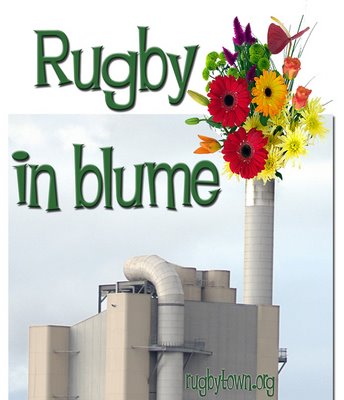
 It's bluming propaganda to hear the Environment Agency and Rugby Cement/Cemex repeatedly saying that the SERIOUS and WIDESPREAD issues concerning the Rugby co-incinerator are:
It's bluming propaganda to hear the Environment Agency and Rugby Cement/Cemex repeatedly saying that the SERIOUS and WIDESPREAD issues concerning the Rugby co-incinerator are:# "within a narrow and local compass, and have limited social and environmental implications"
# and are merely the concerns of a "limited number of individuals" who are vehemently opposed to the ongoing lawful operations of a regulated industry in the town in which they live.
PETITION: The Agency should wake up and listen. Even their own recent Survey of just 530 hand-picked residents showed them how concerned many Rugby people are, but the Agency are only going to "communicate better how we regulate the cement plant". How comforting! 7,500 RUGBY RESIDENTS signed the PETITION (in just a few weeks) against the burning of WASTES (not just tyres) in the Rugby Cement works and this was presented to Tony Blair at Downing Street. Since then there has been a far greater INTENSIFICATION of USE, and we are now the target for London's household and commercial waste.
The manufacture of cement in which about one tonne of carbon dioxide is given off for each tonne made has far reaching consequences for the Climate Change, and global pollution.
Considerations involve: reducing the need for, and use of cement; pollution; health effects; waste disposal; sustainable development; BPEO - Best Practicable Environmental Option; Proximity Principal, etc. These are global, not little local issues as the EA would have us believe. There is a lot of concern here in Rugby in particular because of the nature (semi-wet) of the plant, the huge gaseous pollutant laden emissions (300 cubic metres second?) and the proximity to people.
All over the world cement plants and power stations are being studied as major sources of pollution. The Pulverised Fuel Ash from these power stations is used in cement plants - about 100,000 tonnes a year at Rugby. MERCURY EMISSIONS, hydrogen chloride, and total hydrocarbons among pollutants of great concern at cement plants worldwide. Hot off the press in the USA :
"If cement kilns use such fly ash, the contained mercury is likely to be volatilized in the cement production process and then emitted as air emissions from the kiln. Thus, the kiln's mercury emissions would increase and any benefit (or most of the benefit) of controlling mercury at the boiler would be lost."
Inside EPA July 21, 2006
DESPITE DELAY, EPA UNLIKELY TO ADDRESS MERCURY IN CEMENT MACT
Although EPA is allowing environmentalists more time to comment on a proposed rule revamping its court-rejected air toxics standard for Portland cement facilities, EPA and industry sources suggest the agency is unlikely to require the mercury controls activists are seeking, likely prompting new litigation to challenge the rule.
The agency announced in the July 18 Federal Register that it was reopening the comment period until Aug. 1 on its maximum achievable control technology (MACT) standard for Portland cement facilities to address mercury, hydrogen chloride (HCI) and total hydrocarbons. An EPA spokeswoman says the agency simply agreed to give environmentalists more time to submit comments, and says it is not "reconsidering" anything.
An industry source says the cement production industry will also take the opportunity to again raise its concerns that the rule's HCI controls are too stringent.
Under a court order, EPA was to have finalized the rule later this month, but sources say the environmental litigants and the agency have since petitioned the court for an extension until Dec. 8.
The Portland cement MACT was originally finalized in 1999 but was challenged by both environmentalists and industry in a consolidated case, National Lime Association v. EPA. In 2000, the U.S. Court of Appeals for the District of Columbia Circuit agreed with environmentalists that the rule was too lax and remanded it back to EPA. But the agency never acted on the remand, so environmentalists went back to court and in 2005 reached a settlement that required EPA to revamp the rule.
EPA's revised MACT, reproposed last December, requires existing facilities to control for total hydrocarbons and new facilities to control HCI, but does not impose mercury controls, finding that the cost-per-ton was unjustifiable. That proposal was met with opposition from environmentalists, who argued that it should have included mercury controls, and from industry, who said it may have gone too far in other requirements.
EPA also took comment on whether it should ban the facilities' ability to use fly ash -- a coal byproduct used as a raw material to make cement -- as a way to control mercury in lieu of facility-specific controls. Limestone, another raw material, also contains mercury.
Environmentalists are now pushing hard for the fly ash ban, as well as for mercury-specific control technology. In supplemental comments submitted in April, the Clean Air Task Force wrote, "If cement kilns use such fly ash, the contained mercury is likely to be volatilized in the cement production process and then emitted as air emissions from the kiln. Thus, the kiln's mercury emissions would increase and any benefit (or most of the benefit) of controlling mercury at the boiler would be lost." Relevant documents are available on InsideEPA.com.
Industry, meanwhile, supports continued use of fly ash in cement-making. In Feb. 23 comments, the power company Dominion wrote that it "opposes this ban on the use of fly ash as a cement plant raw material because it appears in the draft rule to be unjustified and not supported by existing scientific data. EPA acknowledges this uncertainty in the draft rule and at a minimum it should gather more data prior to making this decision."
A source with the Portland Cement Association says that despite the delayed deadline for a final rule, EPA is unlikely to require any mercury controls because the technical barriers and raw materials limitations have not changed since the revised rule was initially proposed. The source says environmentalists therefore will likely return to court when EPA finalizes the rule. An environmentalist says activists' understanding of the additional comment time is that EPA had agreed to give "further consideration to mercury control and to the use of mercury laden fly ash."
In a related matter, environmentalists filed suit July 7 over EPA's MACT for large municipal waste combustors, which does not require any additional pollution cuts. Environmentalists say the combustors are responsible for 13 tons of mercury emissions per year plus other air toxic releases. EPA finalized the rule in May despite internal concern that it might allow "backsliding," the environmentalist says.
The source adds that the rule marks the first time that EPA has taken action under Clean Air Act requirements to review and revise incinerator standards every five years, although the rule was officially due in 2000. Sierra Club took EPA to court to win a deadline for the revision, and is now challenging the revised rule as unlawful.



